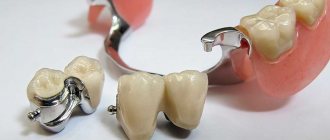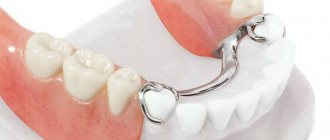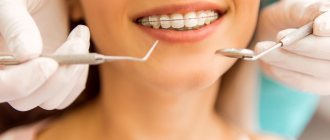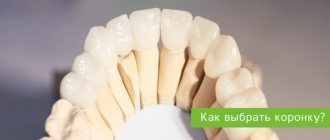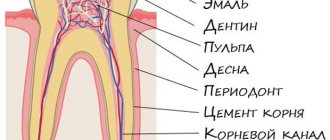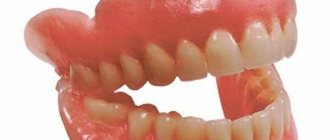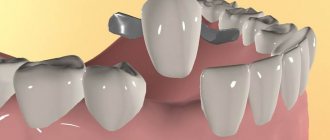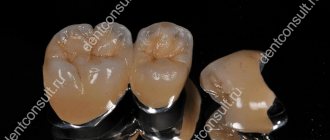Attachment of removable dentures during prolonged wear with intense loads loses functionality. Gradual weakening of locks or hooks requires relining of the removable denture. It is not difficult to determine that you need to contact a specialist for help. During a conversation or eating, gradually progressive discomfort begins to appear.
Relining the removable denture will ensure a tight fit of the structure and will completely normalize the bite. By postponing a visit to the orthodontist, people expose the oral mucosa to danger and the likelihood of injury increases.
Symptoms that should not delay a visit to the dentist
You should make an appointment with an orthodontist if:
- changes in the alveolar process of the upper jaw appear;
- the prosthesis has received damage that is not visible to a specialist, or significant flaws have appeared after prolonged wear;
- the height of the lower third of the face has undergone atypical changes. At the same time, the minimum initial deviations rapidly increase;
- The relief of the oral mucosa changes dramatically during prosthetics or after prolonged use of a stationary prosthesis.
Areas of application of plate prostheses
This type of orthopedic structures has 3 areas of application:
- They are used as permanent dentures in cases of complete or significant absence of teeth .
- Use as temporary prostheses at the stage of osseointegration of implants.
- Use as temporary dentures immediately after tooth extraction. For this purpose, the so-called immediate prosthesis . The main task in this case is aesthetic: to hide a defect in the dentition.
Contraindications
Relining a removable denture is not done if:
- damage to the structure occurred due to a strong impact on a hard object or other mechanical impact that violated the integrity of the system;
- the prosthesis no longer meets the standards necessary for its continued wearing due to loss of integrity;
- there are one or more broken elements;
- anatomical retention is impaired, in which the prosthetic bed is not able to hold the prosthesis;
- The structure is unstable and can fall apart into its component parts at any moment.
The above reasons indicate the futility of relining a removable denture, since urgent production of a new system is required.
Features of relining nylon structures
Patients often wonder whether it is possible to reline nylon dentures. Experts answer that it is possible, but not necessary. Firstly, applying a layer of material to the base leads to its thickening. This may cause the structure to lose elasticity and increase the likelihood of poor fit and discomfort.
The second reason is the increased hygroscopic properties of nylon. During operation, the material became “filled” with microorganisms, the complete removal of which is not possible. As a result, the new material applied during relining will peel off.
On a note! Experts note that the cost of relocating a nylon product can be compared with manufacturing a new one. In addition, it must be taken into account that the service life and quality of the restored structure are significantly reduced.
Advantages of the Denta-Labor team
- Many years of experience More than 20 years in the dental services market
- Modern equipment Expert class dental devices
- Denta-Labor's own training center conducts training courses for dental technicians in Moscow
- Individual approach The client’s wishes and existing orthopedic problem are taken into account
- No unnecessary additional services Completion of work according to a pre-agreed estimate
- Courier delivery We will deliver the dentures as soon as possible
Price
The cost of the relocation service depends on the following factors:
- the location of the clinic where the procedure will be performed;
- clinic level;
- relocation method: laboratory - more expensive, clinical - cheaper;
- level and experience of the specialist;
- specialist status.
Relocation prices vary from 1,600 to 9,200 rubles. However, a high price is not always an indicator of high quality.
First of all, when choosing a specialist, you should focus on reviews of his work. Popular rumor speaks about a good specialist.
So, in Moscow, there are enough craftsmen with more than 10 years of experience and excellent reviews who offer to carry out the procedure of relining the prosthesis for an average of 3000-3800 rubles.
Relocation technique
Orthodontists use two main types of denture relining.
- Clinical . It is limited by the patient’s intolerance to certain synthetic components that cause allergies, or chronic diseases of the oral mucosa.
- Laboratory . The most secure, reliable, convenient.
Only the attending physician chooses a technique based on the patient’s current condition, associated issues, and clinical picture.
Home care
Your dentist may recommend a denture cleaner.
When cleaning a partial denture, it is recommended to stand on top of a folded towel or drain water in case it is accidentally damaged.
Best materials of the month
- Coronaviruses: SARS-CoV-2 (COVID-19)
- Antibiotics for the prevention and treatment of COVID-19: how effective are they?
- The most common "office" diseases
- Does vodka kill coronavirus?
- How to stay alive on our roads?
It is not recommended to use toothpaste as it may be too harsh for cleaning dental devices.
Some people use hand soap or mild dishwashing liquid to clean them, but these products are not acceptable. However, most homemade cleaners are too abrasive and should not be used on dentures.
It is advisable to brush with a special brush every day to remove food deposits and plaque. It's best to use a brush designed for cleaning dentures because it has bristles that are positioned to conform to the shape of the denture. A regular soft bristle toothbrush is also acceptable.
You should avoid using a brush with hard bristles, which can damage it. The device should be cleaned by thoroughly rinsing loose food particles. You need to wet the brush and apply denture cleaner. Next, gently clean all surfaces of the denture so as not to damage the plastic or bend the attachments. It may lose its proper shape if it is not kept moist. At night, the denture should be placed in a soaking solution or water. The dentist can recommend the proper method to keep the devices in good shape.
It should not be chewed, swallowed or rinsed with dental cleaners and should always be rinsed thoroughly before placing it in the mouth.
Do not use household adhesives because they may contain harmful chemicals and may not be useful for holding a removable partial denture in place.
Relocation cost
| Name | Price from | |
| Relining a partial denture | excluding cost of prints | 5500 rub. |
| Relining a complete removable denture | excluding cost of prints | 5500 rub. |
| Repair of acrylic prosthesis | simple, excluding the cost of prints | 3000 rub. |
| Repair of acrylic prosthesis | average, excluding cost of prints | 3000 rub. |
| Repair of acrylic prosthesis | complex, excluding the cost of prints | 3000 rub. |
| Taking impressions | Complex | 2000 rub. |
Advantages of plate dentures
Artificial teeth used for plate dentures have high wear resistance and good aesthetic qualities. With proper use and good hygiene, they do not change their appearance for a long time and can serve for a long time. Moreover, today there are many sets of artificial teeth, which allows you to create the appearance of the prosthesis taking into account the individual characteristics and wishes of the patient.
Modern technologies have also made it possible to make the acrylic base thinner and imitate blood vessels in it. All this makes it possible to make plate dentures very aesthetic.
Features of the clinical method
- Complete examination of the oral cavity, checking the integrity of the prosthesis.
- After analyzing the bite, the size of the marginal area is adjusted. The long one is cut off. Short - extended using quick-hardening plastic substances.
- A small layer of 1 mm will be removed from the prosthesis. The edge fragment loses polishing.
- Thorough impregnation of artificial elements with Vaseline.
- The boundaries of the marginal area are completely treated with a liquid polymer mixture.
- After the outer layer becomes dull, the prosthesis is put on by the patient. It is necessary to close your jaws tightly and hold in this position for a couple of minutes.
- The system is then polymerized in special equipment.
- After ten minutes of treatment, the prosthesis is removed to be adjusted manually. In the finale, he is immersed in hot water.
The advantages of clinical relining of a removable denture include the rapid elimination of existing deficiencies, as well as ideal accuracy. The disadvantages include the high porosity of the material, which reduces the hygiene of the system, and color changes.
Fit and apply the prosthesis.
- He carefully examines the prosthesis from all sides. Looks for sharp edges, protrusions, roughness on the inside of the prosthesis (The inside is the side that lies on the mucous membrane. The outside faces into the oral cavity). If flaws are found, the doctor immediately cuts them off with a cutter (Plastic is always processed with a cutter).
The doctor looks at the quality of the prosthesis. Is there any porosity (gas, granular, compression porosity, remember?). Is it well polished? Are your teeth aligned correctly?
- When the doctor is sure that everything is in order, he disinfects the prosthesis. And puts it on the patient’s jaw.
- The prosthesis should be easy to put on. In the upper jaw, it may be hampered by excessively large maxillary cusps. On the lower side there are undercuts in the retromalar area, on the lingual side. Then the doctor grinds off the base on this side. First on one side (left or right). If it doesn't help, then do both.
Grind off where number 3 is - When the doctor places the prosthesis on the jaw, he checks how well it holds. The doctor presses his finger on the front and side teeth. The prosthesis should not come off. The doctor checks the fixation of the back of the prosthesis by pressing his finger on the front teeth, pushing them towards the lips. The front part - pulling the incisors down or up - depends on the jaw. The stability of the prosthesis is checked in motion. No, the patient is not forced to run. Just move the lower jaw in different directions.
- The practitioner checks for balanced occlusion. He must correct what the technician was not able to fully create. Using occlusal paper (carbon paper), the doctor checks uniform interdental contacts. If they are not there, the doctor selectively grinds the teeth with a small milling cutter, trying to preserve the anatomical shape of the teeth. Until you achieve perfect occlusion.
- The doctor checks the boundaries of the prosthesis using Herbst tests (They were described in the article about taking impressions). The point is that with certain movements, the necessary muscles at the border of the prosthesis tense. And if something is wrong, the prosthesis will be reset. Although it holds up well in a relaxed mouth.
When checking, the doctor may find errors that he had not noticed before. Either he was a fool, or the technician made a mistake, who will figure it out now. In any case, we looked at some errors here. And we don’t want to repeat them. Anyone interested will read it. There were only three types of errors left that were not considered. This is a shortening of the borders of the prosthesis and shortening on the side of line A. And balancing.
Relining of removable dentures using the laboratory method
- The work is performed by a technician in a laboratory.
- The degree of wear of the prosthesis, quality of manufacture, and tightness of fit in the mouth are assessed.
- A control impression is made for transmission to the doctor.
- The surface of the prosthesis undergoes special treatment.
- A copy of the impression and the system are lowered into a ditch, after which they are filled with diluted plaster.
- The cast is taken out, and the resulting void is filled with polymerizing plastic.
- The excess is cut off, after which the product is polished.
The main advantages of the laboratory technique include the absence of contact between the mucous membrane and the plastic, a strong connection between the old and new layers, and an excellent aesthetic appearance. The disadvantages include the length of the process. The patient is forced to go without a prosthesis for several days; errors are possible that require additional time to eliminate defects.
Tissue reaction to the prosthesis
The prosthesis is a foreign body. If everything goes well, as they say, the patient will get used to the prosthesis. If it doesn’t pass, pathology develops -
Prosthetic stomatitis.
This is an inflammation of the oral mucosa caused by a denture.
There are several mechanisms for the development of the disease.
- Violation of thermoregulation . The prosthesis does not transmit heat well. It is like a blanket, covers the mucous membrane, and it heats up. And the higher the temperature, the more comfortable it is for the microbes. Plus, saliva can't wash them away. Microbes multiply and cause stomatitis. Especially if the hygiene of the prosthesis is not the best.
- Negative pressure . A good prosthesis adheres to the mucous membrane and stays on it. The pressure under the prosthesis is less and dilates the blood vessels, causing swelling and congestion of the mucous membrane - stomatitis.
The prosthesis is suctioned like a medical jar
- Traumatic action . An uneven edge or a sharp protrusion injures the mucous membrane. Trauma – stomatitis.
The prosthesis rubs like shoes
- Toxic effect . Two options.
1) Microbial toxins.
2) And the residual monomer is methacrylic acid methyl ester. It even sounds harmful. There is a lot of it if the prosthesis is of poor quality. The monomer irritates the mucous membrane and causes stomatitis.
- Allergic effect . Reaction to some component of the prosthesis (monomer, dye, opacifier, etc.). Usually generalized.
All prosthetic stomatitis are divided into:
- — Traumatic stomatitis . And its complication is a decubital ulcer .
- — Toxic stomatitis.
- — Contact stomatitis.
Traumatic stomatitis
The prosthesis injures the mucous membrane with an imprecise edge or a sharp protrusion.
It all starts with redness and swelling at the site of injury. The mucous membrane hurts.
Traumatic stomatitis occurs in almost all patients. But they pass quickly when the doctor makes a correction.
If the patient does not go to the doctor, a
Decubital (bedsore) ulcer.
It hurts a lot. On the mucous membrane you can see an ulcer covered with a gray coating. The edges are swollen. The mucous membrane around the ulcer is hyperemic.
The ulcer will heal quickly if the doctor removes the traumatic protrusion of the prosthesis and makes a correction.
If not, the ulcer will become chronic. Polyps in the form of petals will grow around it. The bottom is clean and bleeding. Such an ulcer will heal, leaving a scar. It will interfere with the fixation of the prosthesis - the creation of a closing valve.
Toxic stomatitis
It can be bacterial or chemical.
Bacterial toxic stomatitis occurs with poor hygiene of the prosthesis. In addition to bacteria, fungi can grow on the prosthesis. Their toxins will cause inflammation.
Chemical toxic stomatitis is caused by excess monomer.
Both stomatitis look the same: hyperemia, swelling, pain. The only difference is the reason.
Contact allergic stomatitis
This is a local allergy to a component of the prosthesis. Which one is usually impossible to find out.
In the mouth, the doctor sees a clearly limited area of inflammation where the denture touches the mucous membrane. It is bright red and shiny.
Allergies can also be generalized: eczema, glossitis, Quincke's edema, dermatitis of the face, hands, bronchial asthma, etc.
In any case, if the prosthesis is not worn, the allergy goes away.
In this case, there is only one way out - to change the material from which the prosthesis is made. Relining with silicone, nylon prosthesis, etc.
Frequently asked questions - answers:
Which prosthesis is better to choose - domestic or imported?
Perhaps, from an aesthetic point of view, our products are inferior, but in practice they turned out to be much stronger and more reliable than imported dentures.
Why is the denture, which I have been using for less than a year, constantly getting in the way and falling out? This has already begun to cause psychological discomfort.
The implant was simply not adjusted to the end. We advise you to do a relocation; do not worry, there is nothing painful or scary in this procedure.
Why do I need to reline the prosthesis if nothing bothers me?
Reliable fixation of the prosthesis is an extremely important condition for the full functioning of the entire dental system. And, of course, comfort. Any artificial teeth need to be looked after - cleaned and regularly shown to an orthopedic dentist.
To order denture relining in the dental laboratory Denta-Labor, send a request from the website or call the number: +7(495) 162-08-25.
How much does the procedure cost?
The cost of relining dentures consists of several parameters. The final cost is influenced not only by the chosen reconstruction method, but also by the material used, the dimensions of the structure, the type of product (clasp, nylon, conditionally removable, and so on). The region in which this service is provided is of great importance - as a rule, in the central regions of the country, in Moscow, St. Petersburg, cities with a population of over a million, the cost is higher. No less important nuances are the status of the clinic and the qualifications of the specialist. Average prices for reconstruction of removable dental structures range from 3,000 rubles using the clinical method and 6,000 rubles using the laboratory method.
Don't know what type of prosthetics to choose?
We will help in the selection, advise where to read more information and compare types of prosthetics.
Consultation with an orthopedic doctor in Moscow clinics is free! Call now or request a call
Working hours: from 9:00 to 21:00 - seven days a week
On a note! Many clinics include the relining service (not repair, but adjustment to a changing bite) in the cost of a denture. This way you get the design and don’t pay anything for its regular “tuning”. This allows you to significantly save on treatment.
It is also worth paying attention to the fact that within the framework of the warranty (usually 1-2 years), relocation and repairs should be carried out completely free of charge. Be sure to clarify these points when concluding and signing the contract.

